Hyper Personalization with Experro: Elevate eCommerce Success

What’s Inside
- What Is Hyper Personalization?
- How Does Hyper Personalization Work?
- What Is the Difference Between Traditional Personalization & Hyper Personalization?
- What Are the Benefits of Hyper Personalization?
- What Are the Challenges In Hyper Personalization?
- What Are the Best Practices for Hyper Personalization?
- What Is the Use Case of Hyper-Personalization?
- How Can Experro Help You with Hyper Personalization?
- Discover how Experro's hyper-personalization can elevate your eCommerce success to new heights!
- Conclusion
- eCommerce businesses are shifting from traditional to hyper personalization for more individualized customer experiences.
- Hyper personalization uses real-time data and advanced analytics to predict and meet customer needs.
- Benefits of hyper personalization include higher engagement, increased conversion rates, and improved customer retention.
- Experro provides retailers with AI-powered search and merchandising features to help them make the best customer experiences.
As a business, is it possible to make every customer feel special?
Yes! But how?
The answer is through hyper personalization. It revolutionizes customer interactions by making every experience personal and tailored.
Hyper personalization makes a shopping experience feel completely tailored to your customers, turning every visit into a personalized experience.
Unlike traditional personalization, hyper personalization goes deeper, tailoring every interaction for the customer.
For example, retail uses shopping behaviors to offer personalized recommendations. The benefits include higher engagement rates, improved satisfaction, and increased conversions, making it a key strategy today.
Read the full guide here - What is eCommerce personalization?
What Is Hyper Personalization?
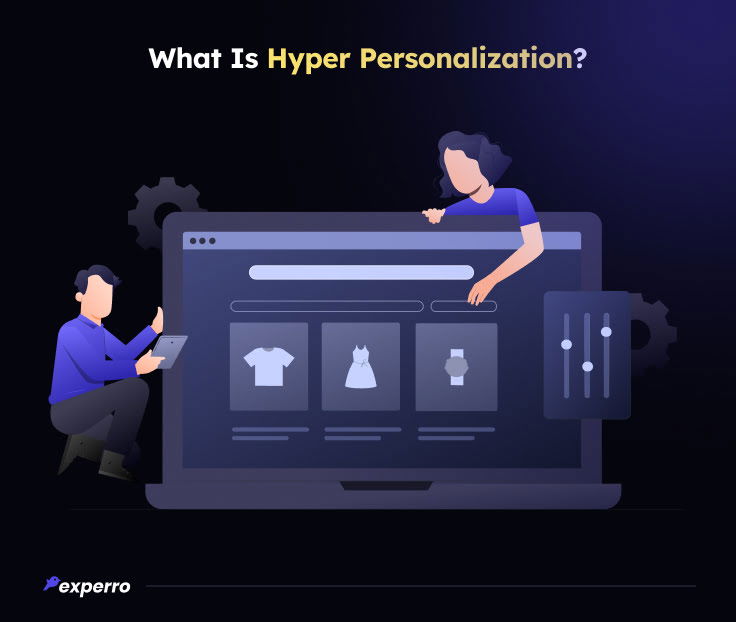
Do you agree? Hyper personalization is the ultra pro max version of personalization!
It is an advanced form of personalization that leverages AI and real-time data to deliver a highly tailored digital customer experience.
The hyper personalization definition goes beyond just customization; it’s about creating a seamless, personalized journey for each customer.
In retail, hyper personalization uses customer data to tailor gen AI-powered product recommendations and promotions, boosting the shopping experience and customer loyalty.
This advancement enables brands for predictive analysis to understand customer needs more accurately. The power of hyper-personalization lies in its ability to create a more engaging and relevant user experience.
Hyper personalization in eCommerce enhances the shopping experience with personalized product suggestions.
How Does Hyper Personalization Work?
Hyper-personalization is the most effective when top brands have a thorough understanding of their customers.
A brand using hyper-personalization tools can find a customer in its database and send contextualized messaging at the optimal time and place as an act of product targeting.
For example, a shopper looking for a diamond necklace only browses online at a certain time of day while on a break without buying.
A business set up with personalization at scale features can deploy algorithms to track and analyze the data the shopper has left via cookies or other means.
This enables them to customize a marketing campaign, sending a push notification with a discount tailored to that specific shopper.
What Is the Difference Between Traditional Personalization & Hyper Personalization?
In digital marketing industry, the terms personalization and hyper personalization are often used interchangeably, but they represent distinct strategies.
Traditional personalization involves tailoring marketing messages based on basic customer data, while hyper-personalization leverages digital experience analytics to deliver highly individualized customer experiences.
This approach goes beyond simple customer segmentation to create a deeply personal and relevant interaction at every touchpoint.
Now, let’s understand hyper personalization vs personalization:
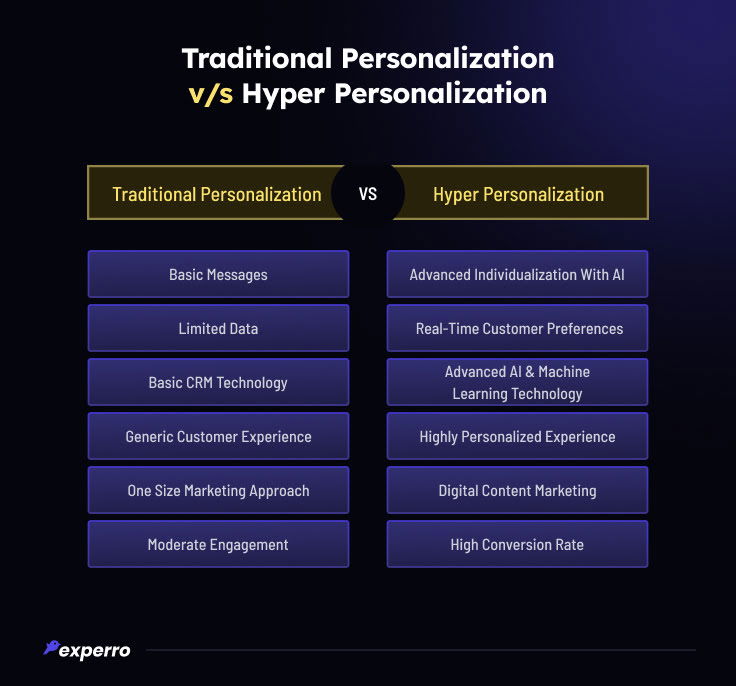
Here is a more detailed version of differences between traditional personalization vs hyper personalization.
Bases of Differences | Traditional Personalization | Hyper Personalization |
| Definition | Basic tailoring of messages using customer data | Advanced individualization using AI hyper personalization techniques |
| Data Utilization | Limited data such as name, location | Comprehensive data including real-time behavior and preferences |
| Technology | Basic CRM tools | Advanced AI and machine learning |
| Customer Experience | Generic | Hyper personalized customer experience |
| Marketing Approach | One-size-fits-all | Hyper personalized marketing with dynamic content |
| Examples | Examples of traditional personalization include sending an email with a name and showing recently viewed items | Examples of hyper personalization include dynamic product recommendations in hyper personalization retail |
Industry Applications | Basic across industry | Innovations in sectors like hyper personalization in banking and eCommerce |
| Effectiveness | Moderate improvement in engagement | Significant increase in conversion and loyalty, showcasing the power of hyper-personalization |
| Benefits | Improved relevance | Maximizes customer satisfaction and loyalty, highlighting the benefits of hyper personalization |
The shift from traditional methods to hyper personalization marketing shows the future of customer interaction. As a result, it provides deeper engagement and higher ROI.
What Are the Benefits of Hyper Personalization?
Hyper personalization plays a pivotal role in customer satisfaction.
Unlike traditional personalization, it makes use of AI and real-time data to deliver highly tailored customer experiences.
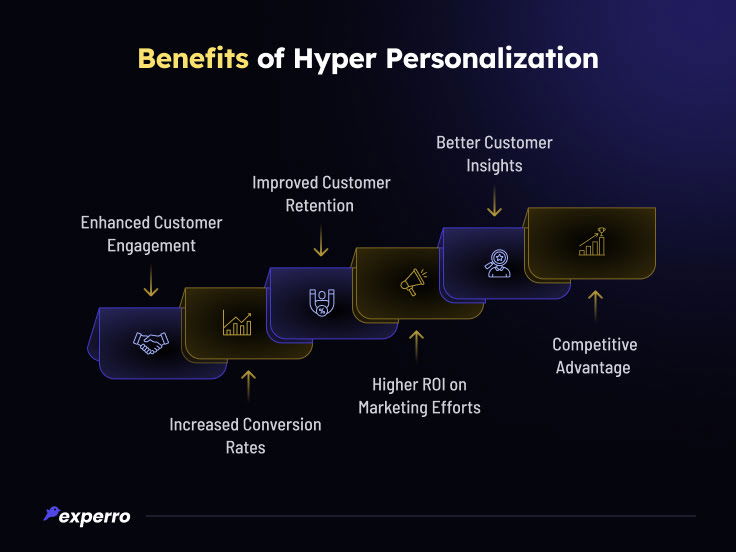
Now, let's understand these benefits in detail:
1. Enhanced Customer Engagement
Hyper-personalization creates more meaningful interactions by offering content and profile-based recommendations that truly resonate with individual customers.
For example, retail hyper personalization uses purchase history and browsing user behavior to suggest relevant products.
This level of engagement ensures customers feel valued and understood, leading to increased loyalty. Hyper-personalization marketing strategies can improve customer experience, satisfaction, and interaction rates.
2. Increased Conversion Rates
Customers are more likely to purchase when they receive relevant product suggestions and personalized offers.
Hyper-personalization uses advanced analytics to predict customer needs accurately.
This approach drives sales and enhances the overall shopping experience, making it easier for customers to find what they need.
3. Improved Customer Retention
A hyper-personalized customer experience fosters strong emotional connections with brands.
By continuously delivering tailored experiences, businesses can improve customer loyalty. This retains existing customers and attracts new ones, reducing churn rates significantly.
Additionally, personalized interactions enhance customer satisfaction and drive higher engagement. Ultimately, this leads to increased sales and long-term growth for the business.
4. Higher ROI on Marketing Efforts
Hyper-personalized marketing ensures that marketing efforts are more targeted and effective.
By delivering the right message to the right audience, businesses can maximize their return on investment.
Generative AI for personalization can automate and optimize these efforts, reducing costs and increasing efficiency. This effect is evident in the improved performance of marketing campaigns, which results in higher revenue.
5. Better Customer Insights
Hyper-personalization provides businesses with eCommerce analytics for deeper insights into customer behavior and preferences.
This data-driven approach allows companies to fine-tune their strategies and offerings.
Hyper-personalization examples from various industries show how valuable these insights can be for strategic planning and growth.
6. Competitive Advantage
Incorporating eCommerce personalization trends into your business strategy can help you stay ahead of the competitors.
The ability to offer unique, tailored experiences gives you a distinct edge.
What Are the Challenges In Hyper Personalization?
Hyper personalization is pivotal in the digital marketing landscape. However, implementing it comes with several challenges.
According to a Gartner study, brands risk losing up to 38% of their existing customer base due to poor personalization efforts.
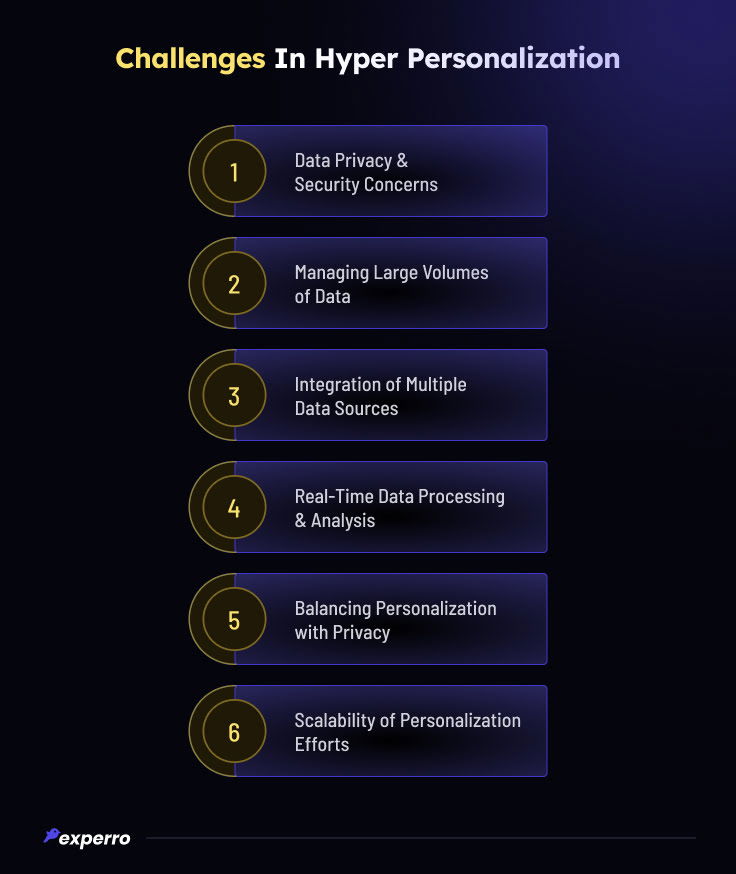
Understanding and overcoming these hurdles is essential to fully leverage the power of hyper-personalization.
1. Data Privacy and Security Concerns for Customer Satisfaction
One of the main challenges of hyper personalization is ensuring data privacy and security. Collecting and using personal data can raise privacy concerns about user privacy. It's crucial to handle data responsibly to maintain trust.
2. Managing Large Volumes of Customer Data
Hyper personalization marketing requires processing massive amounts of data. Managing these large volumes efficiently is challenging. Effective data management systems are needed to handle this data influx.
3. Integration of Multiple Data Sources
Integrating data from multiple sources is essential for hyper personalization customer experience. However, combining data from various platforms can be complex. Ensuring seamless integration is necessary for accurate personalization.
4. Real-Time Data Processing & Machine Learning Analysis
Hyperpersonalization in retail demands real-time data processing and analysis. Quickly analyzing data to deliver personalized experiences is a significant challenge. Advanced AI solutions can help manage this in real time.
5. Balancing Personalization with Privacy
Finding the right balance between personalization vs hyper personalization and user privacy is critical. Overly personalized experiences can feel intrusive. It’s important to personalize while respecting user privacy.
6. Scalability of Personalization Efforts
Scaling hyper personalization efforts across large customer bases can be difficult. Hence, scalability solutions are needed to manage personalization at scale.
There have been instances where personalization has gone wrong for businesses due to a lack of understanding of these challenges. Let’s explore the best practices to ensure it’s executed correctly.
What Are the Best Practices for Hyper Personalization?
Hyper personalization goes beyond standard personalization to deliver relevant experiences to individual customers.
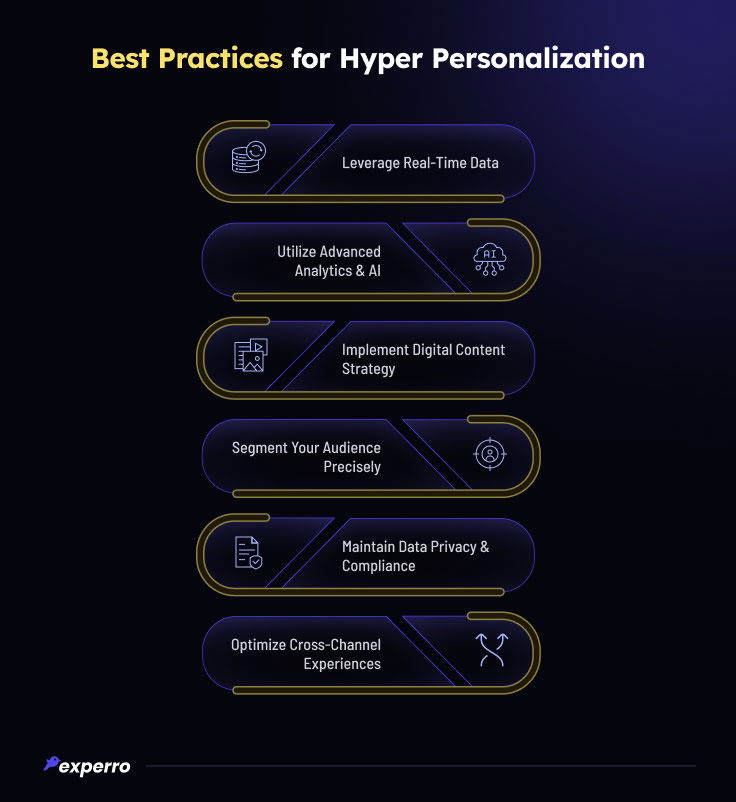
Let's learn more about the practices:
1. Leverage Real-Time Data for Customer Experience
Utilizing real-time data is crucial to complete hyper personalization. It allows you to understand and respond to customer behaviors instantly.
By collecting data from various touchpoints, you can tailor your results to meet the immediate needs of each customer.
This practice enhances the hyper personalized customer experience, increasing engagement and satisfaction.
2. Utilize Advanced Analytics and AI
Advanced eCommerce analytics tools and AI-powered search are at the core of hyper-personalization marketing.
AI-driven features and tools can predict customer preferences and behaviors, enabling hyper personalized marketing strategies.
It can recommend products that a customer is most likely to buy. The power of hyper-personalization lies in its ability to provide highly accurate and relevant suggestions.
3. Implement Digital Content Strategy
Digital content strategy is the key to implementing hyper-personalization. It involves creating content that changes based on the user’s profile and previous interactions.
This approach ensures that each customer sees the most relevant content. Hyper personalization in retail can use the content to show personalized product recommendations on eCommerce sites.
This strategy improves the user experience hyper personalization and boosts conversion rates.
4. Segment Your Audience Precisely
Precise audience segmentation is essential for effective personalization. You can create targeted marketing campaigns that resonate with each group by dividing your audience into specific segments.
This practice benefits hyper personalization in eCommerce, where different customer segmentation based on unique preferences.
Understanding the differences between personalization and hyper personalization helps craft more precise and impactful messages.
5. Maintain Data Privacy and Compliance
Data privacy and compliance are important in the age of hyper personalization. Customers need to trust that their data is secure and used responsibly.
Ensuring compliance with regulations like GDPR is critical. This practice not only protects your business but also builds customer trust.
Highlighting your privacy and consent management commitment can enhance the hyper personalized customer experience.
6. Optimize Omnichannel Experiences
Optimizing omnichannel experiences in eCommerce is vital for hyper personalization. Customers interact with leading brands across various channels, and ensuring a seamless experience is crucial.
Omnichannel hyper personalization in marketing should provide consistent and relevant interactions, whether the customer is on a website, app, or social media.
This unified approach enhances the overall hyper-personalized content, driving better customer loyalty and satisfaction.
What Is the Use Case of Hyper-Personalization?
Hyper-personalization is transforming the way businesses interact with their repeat customers. It provides highly tailored experiences that drive engagement and sales.
Here’s a notable example of hyper-personalization in the eCommerce industry:
Nike
We have been stating that personalized results enhance the user experience in eCommerce. By analyzing user search queries (shoes in this case), the site suggests relevant categories and specific products tailored to the user's interests and needs.
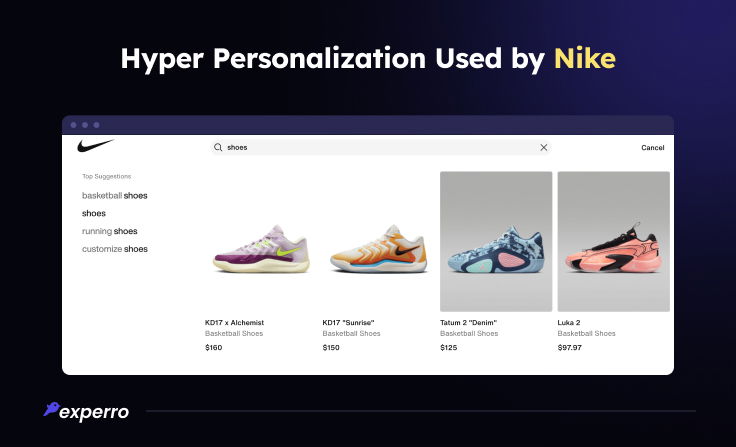
Nike leverages hyper-personalization by using artificial intelligence to analyze customer data and provide personalized product recommendations.
Their app offers tailored workout plans and suggests products based on individual preferences and past purchases.
This enhances customer engagement and boosts sales by ensuring each interaction is relevant and valuable.
How Can Experro Help You with Hyper Personalization?
Experro is a DXP that excels in two key areas: AI-powered search and machine learning driven merchandising.
These functionalities work together to enhance customer satisfaction, boost engagement rates, and drive better conversions, especially in the retail sector.
Experro helps in enhancing Agentic personalization in eCommerce by using data analytics for tailored search personalization results and product suggestions. This approach ensures every interaction is relevant, boosting loyalty and sales.
By using eCommerce analytics, Experro helps businesses offer hyper personalized experiences, making each customer interaction meaningful and valuable.
Conclusion
In conclusion, hyper personalization approach goes beyond traditional methods, offering tailored interactions that increase satisfaction and conversions.
According to McKinsey, over 70% of consumers expect hyper personalized experiences and become frustrated when their expectations aren't met.
With AI-driven personalization, businesses can analyze customer needs and optimize interactions.
Experro, as a complete DXP, enhances this by using data analytics to tailor search results and product suggestions. The platform also ensures that every customer interaction is meaningful and valuable.
Stay tuned for further updates, or schedule a call with our team for a one-on-one discussion!
FAQS


Pallavi Dadhich
18 June 2024Pallavi is an ambitious author known for her expertise in crafting compelling content across various domains. Beyond her professional pursuits, Pallavi is deeply passionate about continuous learning, often immersing herself in the latest industry trends. When not weaving words, she dedicates her time to mastering graphic design.